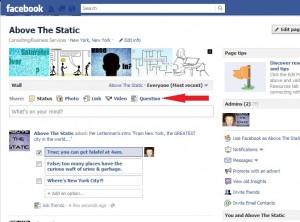Music Marketing Matters: 6 Secrets To Gathering Fan Data
Last week’s near essay took you through the significant process of setting up your fan database. With that being the crucial foundation of your renewed focus on getting the most from your data, I thought I’d take it easier this week.
As a useful redux to that piece, today we’ll run through some brief places that you can use to seek out previously uncovered fans (and the accompanying data that they bring… do you think I’m obsessed yet?)
Where the Wild Fans Are
 Chances are you gather most of your new fan data from e-mail addresses, either taken at live shows or those that you’ve managed to tempt into sign up online. In most cases, you’re missing out an important portion of building out, and connecting with, your fan base.
Chances are you gather most of your new fan data from e-mail addresses, either taken at live shows or those that you’ve managed to tempt into sign up online. In most cases, you’re missing out an important portion of building out, and connecting with, your fan base.
Granted, they’re not necessarily all that wild, but they are out there in the wilds of Internet listening, often taking in your music but not connected to your artist-to-fan channels. Sometimes this will be by choice, other times a result of simply not having linked up to them… yet.
The former we will leave in peace. But the latter?
These are the folks that we want to target, with laser-like precision, and bring into the comforting fold of your warm and fuzzy artist updates.
But how to find them?
6 Steps to Gathering New Fan Data
As I said, we’ll get straight to the point today. Following are six steps that you can take to search out and identify disconnected listeners, with the objective of recording their data and requesting their permission to e-mail them from time to time.
(Note that some of these pointers will also be useful in filling any blanks in your fan data, as we discussed in How To Win Data & Influence People.)
1. Target Twitter
With its public data flow and two way communication, Twitter is an ideal place to scout out new fans and listeners you haven’t yet found. The search function gives you a simple place to search for your name or artists with whom you’ve recently played. Beyond that, look at the possibilities of mentions of local towns AND a related musical genre. Obviously if the individual is not listening to your music specifically, you have more work to do in building the relationship and connecting the dots to your tunes. Pursue that as far as you wish but, as a minimum, use a Twitter manager such as Hootsuite and set up a search tab on your own name and your artist moniker, if different. Alternatively, obtain the RSS feed for the search and have it delivered to your inbox daily (tweet me @AboveTheStatic or leave a comment, if you need to know how to do so).
2. Go Facebook Foraging
Despite being a closed network, you can gain access to a lot of potential fan data from information that people choose to share and that glimpsed from connections to your existing network of friends and fans. Open groups related to your genre, Spotify playlists that friends listen to and are shared through Facebook’s ticker, fan pages of artists with whom you’ve recently played, and pages of blogs who have featured your music or that similar to it, are all spaces that you should explore, from time to time, to note down any names of those name checking you or subjects related to you. Once you have a name – and this is something you can simply do one person at a time, as you have a few spare minutes – drill down to their page for any further information. If none is available, any common friends you have may provide an introduction. Failing that, you can Google them to see if there are any other web platforms available that offer an easier opportunity to connect than the generally more private realm of Facebook.
3. Look Over Last.FM
Although it has been around for years, Last.FM is often overlooked by artists as a forum to connect with fans. Despite the limited number of users, it has the benefits of almost a decade’s worth of fan listening habits stored up in its wealthy data banks. Obviously start with your own fan page and anyone mentioning your music, following the same process of drilling down to their individual user page to note down more information, but spread out that search to the similar artists, areas, and common musical interests, if you have the chance, in case people are looking for recommendations or an opportunity exists to strike up conversation with a fan around matching musical tastes.
4. Bottom Of Blogs
Way down below the articles of your favorite music blogs, a comments section holds the real buried treasure in the form of individual music fans offering their opinions. If you’re on Brooklyn Vegan, this will, admittedly, be largely comprised of moronic h8r hipsters and related in jokes. Elsewhere, however, you can unearth fans of both your own and similar styles of music. Start with blogs that you know have previously covered you (double check on Google’s blog search, Hype Machine, and elbo.ws, if you haven’t done so in a while) to track back and check the comments sections. Answer any questions and, again, click through to see if you can obtain more information on those commenting. You can also think laterally on this one, branching out to blogs and websites that cover subjects close to those that your songs address and building relationships with like-minded folks in those environments.
5. Ask Fellow Artists
Put simply, ask similar artists – preferably those with whom you’ve played or previously connected – to connect you with fans of theirs who they think will enjoy your music. Reciprocate for them with your own audience, as and when the opportunity arises. You can, of course, review the active fans of other artists on the platforms that we’ve already mentioned, but that recommendation from a trusted source will go a long way to adding authority and interest to your approach.
6. E-mail Individuals
Take every individual that you’ve gathered via the preceding steps and send them a personalized e-mail introduction. If you haven’t been able to gather an e-mail, it’s preferable to make a subtle ask for it via another platform, if the relationship has been established. If not, hold off and look for further opportunities to connect until it reaches that level. Make your intro more about them and their musical tastes than your own work. Keep it short, friendly but to the point, and add a note that they won’t hear anything more from you on the e-mail front, unless you hear from them and obtain permission.
That’s it!
Obviously some of this is more speculative than simply finding someone listening to your music and will take longer to develop, but don’t view that as a barrier. As Stan Stewart pointed out in a recent commentary, you have limited time available as an independent musician and you’d rather be creating for much of it. I understand this and would just advise you to carve out up to an hour for these data building activities every week or so.
Allocate just a little regular attention to setting your fan data foundation, then consistent data gathering and relationship building, and you’ll soon find that you have a lot of information to work with. Be it for your next tour plans, music release, or even polling fans for more information, this data will be invaluable to you when the time comes for your next big music move.
Over To You…
What stage are you up to with your data collection? How could it be improved?
Where could you gather more information about those who are listening to your music but aren’t on your radar?











 Tools
Tools
Connections